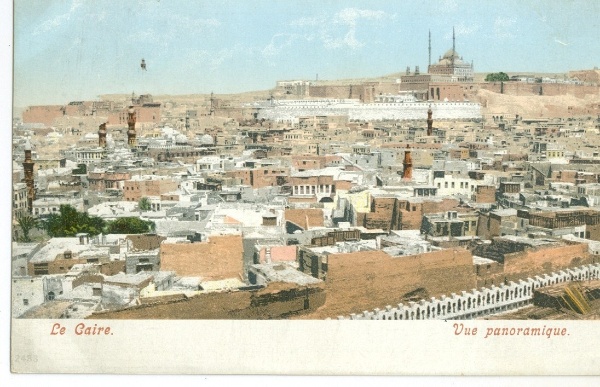Greetings from Egypt! أهلاً في مصر
Egypt, known in Arabic by its sobriquet “Mother of the World” (Umm al-dunya, أم الدنيا), remains the most important and -studied country and culture in the South-West Asian/North African region. A recently acquired collection of 163 postcards (dating from the 1880s to the 1930s) provides an immersive overview of some of the wonders and joys of Egypt, from the north of the country in cities like Port Said and Alexandria to iconographic places like Cairo and Luxor along one of the most important waterways in the world, the Nile River.
Cairo
Cairo (القاهرة- al-Qāhirah), the capital of Egypt, is a megacity, with a current population of more than 20 million people, or about one fifth of the country’s total population.  This panoramic view of Cairo (French: Le Caire: Vue panoramique) depicts the city’s Citadel complex. Originally built in the 9th century, it has had many additions throughout its history. In the 12th century, Saladin (Salah al-Din, 1171-1193), the Kurdish-born sultan of Egypt and Syria, fortified the complex to stave off the attacks of the Crusaders. Successive Muslim rulers have since then added to the Citadel. The large alabaster mosque in the upper-right corner of this image is named after Muhammad Ali Pasha, an Albanian-born Ottoman governor and the de facto ruler of Egypt from 1805 to 1848, who is considered the founder of modern Egypt. He is also credited with the development of the Bulaq (Bulak) Press, one of the most important printing press operations in the Middle East.
This panoramic view of Cairo (French: Le Caire: Vue panoramique) depicts the city’s Citadel complex. Originally built in the 9th century, it has had many additions throughout its history. In the 12th century, Saladin (Salah al-Din, 1171-1193), the Kurdish-born sultan of Egypt and Syria, fortified the complex to stave off the attacks of the Crusaders. Successive Muslim rulers have since then added to the Citadel. The large alabaster mosque in the upper-right corner of this image is named after Muhammad Ali Pasha, an Albanian-born Ottoman governor and the de facto ruler of Egypt from 1805 to 1848, who is considered the founder of modern Egypt. He is also credited with the development of the Bulaq (Bulak) Press, one of the most important printing press operations in the Middle East.
The Mogamaʻ (مجمع)
This striking image is a photograph of the Mujamaʻ, or Mogamaʻ in Egyptian dialect (مجمع التحرير). The Mogamaʻ stands over Maydan al-Taḥrīr (ميدان التحرير) in the bureaucratic centre of Cairo. The building was constructed on the orders of King Farouk and was designed by Muḥammad Kamal Ismāʻil, an Egyptian engineer and architect to be a government building—see this map for an overview of different offices. Ismāʻil also designed the expansion of the Great Mosque of Mecca and the Prophet’s Mosque in Medina. The Mogamaʻ was completed in 1952 shortly before the ‘Free Officers’ coup and the rise to power of Gamal Abdel Nasser. It stands at 14 storeys as a towering figure over Taḥrīr square, its architecture garners many debates from those who consider it magnificent and those who object to its utilitarianism. For better or worse, the Mogamaʻ recently closed, in part due to its dilapidated state. It is now being refurbished and remodeled into a luxury hotel.
Maydan al-Taḥrīr, from where the Egyptian revolution of 2011 took place is in the foreground of the photo and to the right of the Mogamaʻ is the Omar Makram Mosque. Omar Makram was a political leader of the late 18th century, his mosque was designed by the Italian architect, Mario Rossi. Rossi designed or helped design several important mosques in Egypt.
The Nile
Cairo sits on the headwaters of the Nile River, which has provided the water for not only the capital but also the entire country from time immemorial. The importance of water and the Nile is apparent in the following postcard, which references to one of the historically more important jobs, that of the water bearer (saqa, سَقى). Water bearers, a profession dating back to ancient times were generally young, healthy men who, according to this al-yawm al-sābiʻ article had to prove their endurance and strength by carrying a 67-pound bag of sand for 3 days and nights without sitting or sleeping. Once passing this test, a saqa delivered fresh drinking water to the public water fountains (sabil, سبيل) for locals to drink freely. The profession no longer exists, at least in the traditional form due in large part to the founding of the Egyptian water company in 1865.
Qahwah (قهوة)-Kahve (Turkish)-Coffee
The fascinating history of coffee has been condensed by the rappers Omar Offendum & Thanks Joey suggest in this YouTube video, the Story of Qahwah ☕️ is the story not only of Egypt, but the entire Middle East.

This postcard depicts a typical Cairo street scene, showing men playing backgammon next to a large coffee stand manned by a young barista. The coffee stand includes a representation of a Turkish coffee pot (Turkish: cezve, Arabic: جذوة), a small, long-handled pot with a pouring lip designed specifically to make Turkish, Arab, or Greek style coffee. It is traditionally made of brass or copper, occasionally also silver or gold.
Duke University Libraries’ Egyptian Postcard Collection: https://archives.lib.duke.edu/catalog/egyptpostcards includes many more fascinating images. For more information about the collection, contact Sean Swanick, Librarian for Middle East, North Africa, and Islamic Studies.



